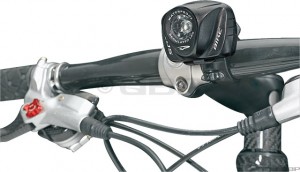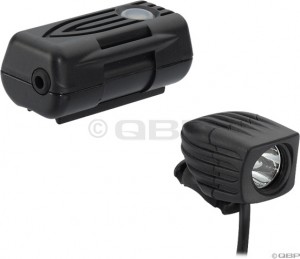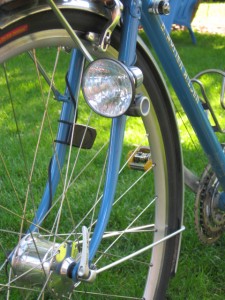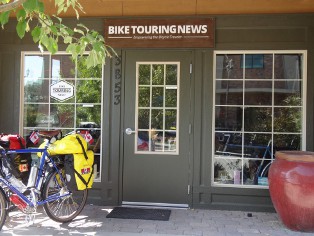Inevitably, if you are traveling by bicycle, you will get caught in the dark. Whether you are just getting an early start to meet the day’s mileage goal, or you get lost looking for that camp site. Either way you will wish you had a reliable, efficient and powerful light source. One on the front to light the way and one on the rear for safety.
There are three options for power sources for your headlights. And they each have pros and cons.
Option one: Lights powered by disposable batteries.
Pros
– This is the least expensive option with prices for a headlight ranging from $15 to about $60.00 with prices for a combination head and tail light running about $30 and up.
– These lights are light weight.
– Lights like the Princeton Tec Eos pictured here have an impressive output.
– The Princeton Tec lights have a helmet mount option, and the Eos has a headlamp attachment for around the campsite or completing bike repairs in the dark.
Cons
– You need to carry spare batteries.
– The light output of some of these headlights is marginal.
– Sometimes the bracket supplied to attach the light to the bike is flimsy and can break.
Bike Hermit’s opinion:
Leave these lights on the commuter bike. They aren’t made to stand up to the rigors of bike touring. And the light output is not enough to illuminate the road.
Option two: Lights powered by re-chargeable batteries.
Pros
– Some of these lights provide an extremely bright output
Cons
– The combination of the battery and the charger can be heavy and bulky
– You must remember, and be able to, recharge the battery regularly
– The battery may have a limited life.
– It may be difficult to tell if the battery has an adequate charge
– Expensive. Plan on spending $200 and more for a decent quality set up.
– The makers have a habit of changing their products every few years, rendering your expensive light obsolete, and making finding replacement parts and accessories challenging.
Bike Hermit’s opinion:
These lights certainly have enough output for the touring cyclist, but the inconvenience of carrying a battery and a charger, and of finding someplace to plug it in would just add another level of complication and worry.
Option three: Hub dynamo powered lights.
With these systems, the power source is actually provided by the rotation of the front wheel which incorporates a hub capable of generating electrical current. The light(s) are plugged into the hub- so as long as the wheel can go around, there is power to the lights.
Pros
– Most reliable of the three
– No batteries or chargers to keep track of
– There are many options for high output, efficient lights
– Option of running a tail light off the hub dynamo
– The better lights in this category have a focused beam, made specifically for lighting the road for the rider.
Cons
– Expensive. $200 to $600 for the front wheel incorporating the hub, and the light.
– There is a little more drag or resistance from the dynamo hub than from a regular hub.
Bike Hermit’s opinion:
This is definitely the way to go for dependable efficient lighting, without any of the hassles or headaches of the other options. The better systems such as those made by Schmidt and Busch & Muller are worth every penny in durability and performance. Shimano and Sanyo also make dynamo hub and light systems.
Addendum:
Sky King brought to my attention the fact that some people might wonder what happens to the dynamo powered light when the bike comes to a stop- like at a stop sign. Well, the light goes out, unless you have a light that includes a standlight. There is a capacitor in these lights which stores energy to power the light for a few minutes after the bike stops. Good safety feature.
This also got me thinking about doing things like repairing a flat tire at night. You obviously can’t use your dynamo light to see with, so carrying an additional headband style camping light is a good idea. These are pretty light and compact and inexpensive, and you will want one for camping anyway.




Jack Kessler March 15, 2013, 10:56 pm
I disagree with Bike Hermit. The normal and usual situation is that one is bicycling in daylight. It is an unusual situation such as unexpected delays or no-room-at-the-inn when one has to ride in the dark. With a dynamo on the wheel one fights the drag of the dynamo night and day even if one needs it only once or twice a season. If one has a headwind as well, it is just miserable.
Rechargeables work just fine – if one has a place and time to recharge. For touring, the destination can be a campsite or just a flat place in the weeds. The next day one can stop for four or five hours to recharge if one finds an electrical socket or just say the hell with it and take one’s chances without a light, which is nervous-making.
As Bike Hermit says, lights with replaceable alkaline batteries are not too bright. But one is no longer limited to them. Some of the Cygolite, NiteRider, and Serfas lights are powered by proprietary battery sticks. They are $30 each which is outrageous but one can keep two or three in a pannier and swap them out until time and electricity become available.
A better solution is the Fenix BT20 which uses lithium ion batteries. One can use two 8650 AA-shaped cells or four CR123a cells. The importance of the latter is that Walgreen’s carries them and Walgreen’s is everywhere. Walgreen’s are robbers and charge $17 for a pair but compared to riding in the dark, they are cheap at twice the price. With a little foresight one can buy them for a buck or two apiece at Amazon and have a handful in one’s panniers. Or even mail them to yourself c/o General Delivery at a town you know you’ll be in.
The downside of the BT20 is that it has an external battery pack which I consider to be clutter and a nuisance, but there seems to be nothing else.